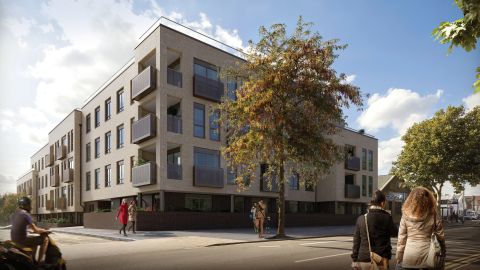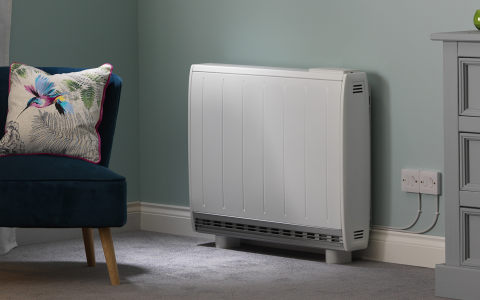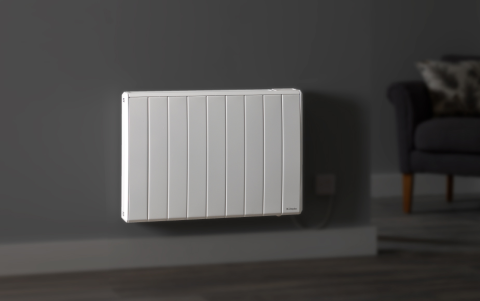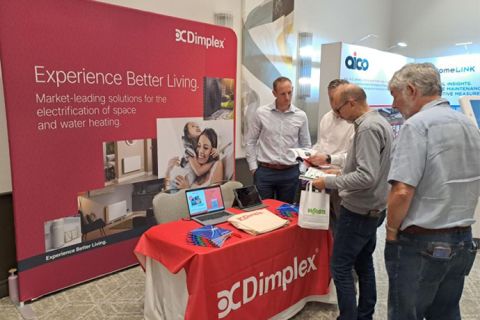
Church Road, Galliard Homes
- Zeroth Energy System
- LATU air source heat pump
A development by Galliard Homes at Church Road, in London's Leyton, is one of the first in the UK to showcase the benefits of the cutting edge Zeroth Energy System, an ambient loop solution specified to provide an energy-efficient, low-carbon heating and hot water for the modern, large urban development.
The Zeroth Energy System was designed and manufactured in cooperation with industry experts with a focus on performance, however, every aspect of the solution was addressed. The Church Road installation demonstrates how industry-driven innovation works in practice to deliver financial and practical benefits, along with improved energy efficiency.
Church Road, Galliard Homes
-
PDFDimplex - Case Study - Church RoadDownload
The Zeroth Energy System specified to provide energy-efficient, low-carbon heating and hot water for modern urban development at Church Road
A development by Galliard Homes at Church Road, London, is one of the first in the UK to showcase the benefits of the cutting-edge Zeroth Energy System by Dimplex. The ambient loop solution was specified to provide energy-efficient, low-carbon heating and hot water for the modern, large urban development.
The 48 contemporary one, two and three-bedroom apartments, and two luxurious three-bedroom townhouses with a fast link to central London, boast high specification. Focus is on providing residents with ample space in the apartments, yet retaining the feeling of communal living. Roof terrace gardens or private gardens are available with some units. Each apartment has a balcony or terrace. Access to the communal, landscaped gardens and secure bicycle storage cement the connection of the occupier with the surrounding environment.
In view of the ambitious plans for a low-carbon future for the UK, as set out in the London Plan and Clean Growth Strategy policy, use of renewable energy sources and low-carbon technologies is key to a successful housing development. The project was completed in 2020 and whilst the now familiar 2021 updated Part L and Part F had not yet come into law at this point, it was obvious that any new developments required a substantial energy strategy.
Engineering Design Consultants (EDC) were contracted by Galliard Homes to source and plan a heating, ventilation and air conditioning (HVAC) system to fit the design challenges of the development. The Zeroth Energy System, an ambient loop, was chosen to provide a low-carbon and high-efficiency heating and hot water solution to complete the green living arrangement.
The Zeroth Energy System offers answers to the challenges of HVAC specification in larger urban developments
As a result of the urgent demand for more housing, and the lack of undeveloped ground space, we are seeing a resurgence of high-rise developments in already densely populated urban areas. The changing landscape of compliance and design of increasingly airtight buildings has highlighted an energy performance gap that can only be overcome by innovation in HVAC technology. By specifying new technology today, developments can be closer to achieving net-zero status whilst creating healthy buildings now and in the future.
The tightening of the building envelope performance amplifies issues with thermal inefficiency of traditional heating systems. It isn’t news that high-temperature systems can suffer from a high degree of heat loss through the pipework, especially in large buildings. The unutilised excess heat, depending on the permeability of the building envelope, is either lost into the environment, potentially giving rise to the urban heat island effect, or ends up trapped in the building causing condensation and raising the temperature in the corridors and overall building. The more heat that is lost on the journey to the living space, the more the occupant needs to draw from the central plant to meet their thermal requirements. According to BRE research, the heat loss within pipework can result in an overall system efficiency dropping as low as 33%. The result is a less efficient system which impacts the cost to the end-user. There are also tangible environmental and financial consequences to consider for developers; gaining compliance, ongoing operational and maintenance costs.
The initial plan for the Church Road project was to integrate a traditional central plant heating technology within the development, however, an issue with insufficient space for the plant room was discovered in the preplanning stage. This could not be overcome by redesign, and alongside limits to the available electrical supply and a Galliard Homes safety policy that prohibits installation of individual gas boilers within apartments, a challenge needed to be overcome with some innovative specification and design.
EDC consulted with Dimplex, who have a longstanding relationship with Galliard Homes, regarding the benefits of the Zeroth Energy System. The newly designed solution has an ambient loop operating at a temperature of 25°C. The heat pumps, connected to a water cylinder in each apartment, are capable of providing hot water up to 60°C. A central heating plant maintains the overall operating temperature. This methodology minimises the distribution losses and mitigates the overheating, resulting in a high system efficiency. When modelled in SAP 2012, the system presents well and in conjunction with the installed air source heat pumps (ASHP) can offer efficiencies up to 300%. This significant contribution to the carbon reduction targets helped achieve easy compliance with building regulations.
Installation of the Zeroth Energy System brings financial benefits to the developer and occupier
The Zeroth Energy System was designed and manufactured in cooperation with industry experts with a focus on energy performance. However, every aspect of the solution was addressed in the design. The Church Road installation demonstrates how industry-driven innovation works in practice to deliver financial and practical benefits, along with improved energy efficiency.
The initial issue with insufficient space for the plant room was resolved with a number of strategies. As an ambient loop requires a smaller output compared with higher temperature alternatives, a reduction of the central plant size was possible.. The flexibility of the Zeroth Energy System offered easy integration with other low-carbon technologies. The Church Road development saw an installation of additional air-source heat pumps (ASHP) on the roof. This reduced the plant size further still, saving on costs and allowing for better use of the newly available space. The water cylinder and heat pump installed in each apartment are sized to fit a standard utility cupboard whilst the pipework for the heating and hot water supply is hidden.
The hydronic delivery system of the Zeroth Energy System as a solution allows for flexible use of emitters, from underfloor to wet or smart radiators, for heating and fan coils when using comfort cooling.
The design choice for Church Road included wet radiators with individual in-apartment control units which place the occupier in charge of their thermal comfort and energy bills. The choice of system design, and the resulting extra usable space an ambient loop can generate, gives architects more freedom to create a quality living space and offer valuable extra features in the buildings. The specified version of the Zeroth Energy System was delivered preplumbed and prewired, helping with the installation. A simpler and quicker installation presents valuable savings with time-on-site, increasing the return on investment of a development.
Maintenance and repairs can put pressure on resources throughout the life of any residential development and whilst heat pump technology is robust, ambient water loops offer additional benefits when compared to high-temperature systems. The individual heat pumps are modular in nature and each cylinder has a backup immersion heater. This means convenience for the occupier as the Zeroth heat pump can be easily swapped out for another unit to allow for maintenance or repair of the original whilst the hot water supply remains completely unaffected.
Does the Zeroth Energy System play a role in the decarbonised smart energy grid of the future?
The review of 2021 updates to Part L and Part F of Building Regulations in anticipation of the Future Homes Standard was indicative of the UK government’s intention to electrify heat generation in our buildings. In order to achieve the net-zero targets set for 2050, decarbonisation efforts may intensify and building technologies will have to keep up. The flexible and reliable technology behind the operation of the Zeroth Energy System is crucial for the reduction of carbon emmissions and increased energy efficiency of the building and invaluable for futureproofing of the development.
The high level of flexibility and ease of installation, without the need for specialist installers, means the Zeroth Energy System is ideal for application in modular construction. It can help reduce the time on site and offers a degree of flexibility when changing the design of a modular building without the need to retrofit the entire HVAC solution. This flexibility can be used to upgrade the plant should the energy strategy of the building change or if a connection to a heating network is preferred. District heating networks, already popular in Europe, are receiving increasing support in the UK. The plans for some of them to utilise excess heat is likely to make them popular for urban and metropolitan residential buildings of the future.
Dimplex advocates a holistic approach to building efficiency. The easy integration with renewable, low-carbon technologies plays an important part in affording the architect and designer a high level of design freedom. This means all limitations of the project can be addressed to ensure the HVAC systems work in harmony with the building.
“We’ve always been promoters and supporters of leading cutting-edge technology, and we could see the benefits that the Zeroth Energy System could bring. The implementation of this solution produced heating and hot water in a low-carbon way while staying within the limited electrical power available for the site. However, the real beneficiary will be the end-user, with very low energy bills and increased thermal comfort.”
When specified with cooling, the Zeroth Energy System can recycle the waste cooling that occurs when the heat pumps transfer energy to provide comfort cooling and vice versa. The excess heat from the cooling process can be utilised to provide ‘free’ hot water. The life cycle carbon losses of the building can be drastically increased.











